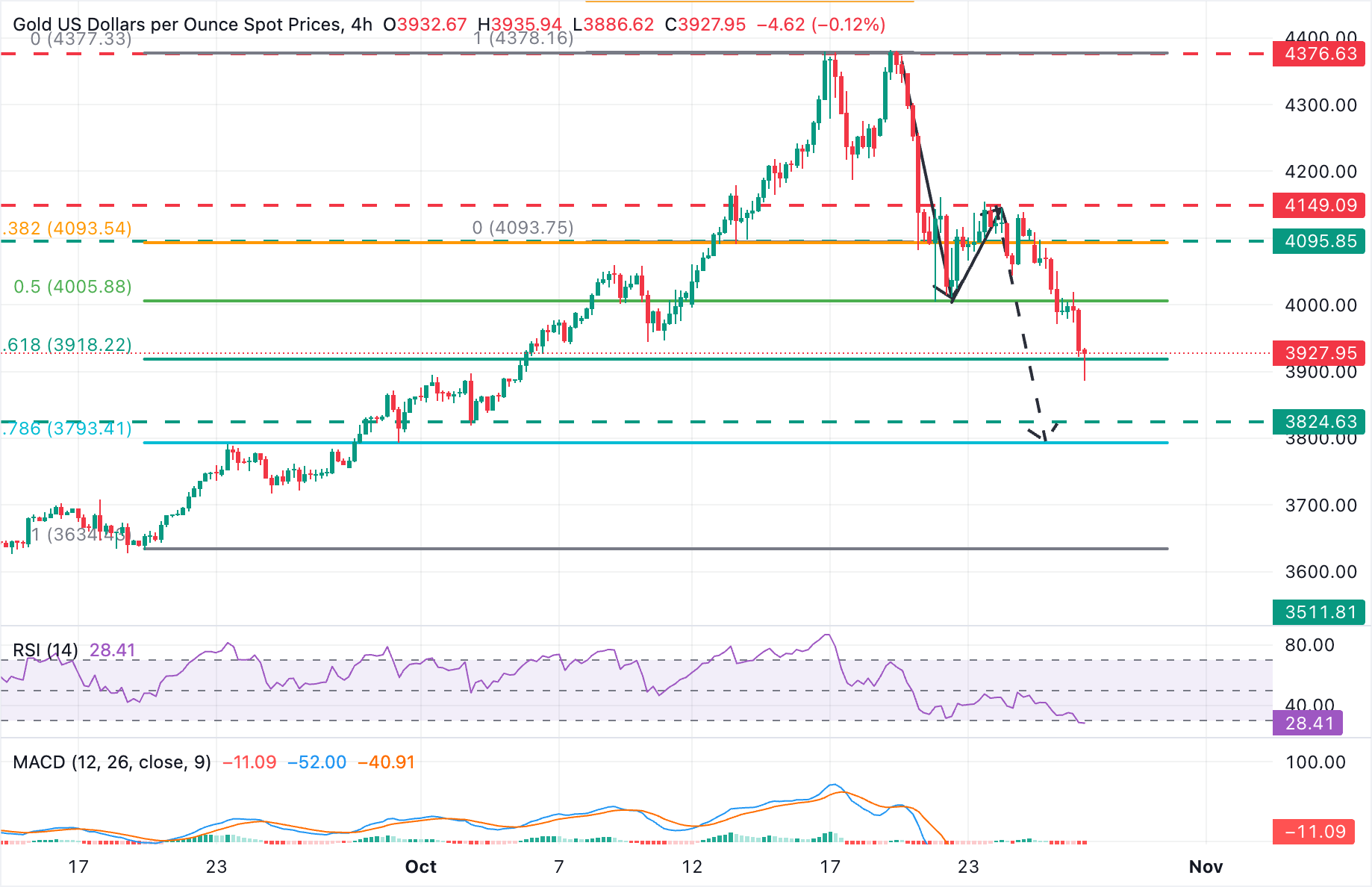Gold Price Forecasts: XAU/USD hits lows sub-$3,900 weighed by risk-on markets
- Gold extends losses on risk appetite, hitting three-week lows below $3,900
- A US-Japan deal and hopes of further de-escalation of the Sino-US trade frictions are boosting risk appetite.
- XAU/USD's correction might extend to the $3,800 area.
Gold trades lower for the third consecutive day on Tuesday, depreciating beyond 4% so far this week, as new trade agreements between the US and Asian countries underpin investors' appetite for risk, weighing safe-havens like Gold. The Precious metal hit fresh three-week lows at S3,886 earlier on Tuesday before returning to levels right above $3,900 at the time of writing.
US President Donald Trump has signed an agreement with the Japanese Prime Minister, Sanae Takaichi, to secure the supply of rare earths, which has contributed to supporting investors' appetite for risk. The focus, however, remains on the Trump-Xi summit later this week, with the advances in the talks between US and Chinese representatives in Malaysia this weekend and the signs of de-escalation, mainly from the US side, are boosting hopes that a trade war will be averted.
Technical Analysis: Gold is correcting lower from all-time highs

A look at the 4-hour charts reveals an immediate bearish trend, with Gold prices correcting lower after having rallied more than 30% since late August. A failure to regain a previous support level, at $4,010 on Monday, has confirmed that the negative trend remains in play.
Prices are now testing the 61.8% Fibonacci retracement of the September 18- October 17 bull run, at the $3,920 area. An A-B=C-D correction would target the confluence of the September 30, October 2 lows, with the 78.2% Fibonacci retracement of the previously mentioned cycle, in the area between $3,795 and $3,830.
Upside attempts are likely to be challenged at the October 22 low, in the area of $4,010 and the $4.150 (October 22 and 23 highs). Further up, the previous support $4,185 area might hold rallies ahead of the all-time high, near $4,380
Fibonacci
Gold FAQs
Gold has played a key role in human’s history as it has been widely used as a store of value and medium of exchange. Currently, apart from its shine and usage for jewelry, the precious metal is widely seen as a safe-haven asset, meaning that it is considered a good investment during turbulent times. Gold is also widely seen as a hedge against inflation and against depreciating currencies as it doesn’t rely on any specific issuer or government.
Central banks are the biggest Gold holders. In their aim to support their currencies in turbulent times, central banks tend to diversify their reserves and buy Gold to improve the perceived strength of the economy and the currency. High Gold reserves can be a source of trust for a country’s solvency. Central banks added 1,136 tonnes of Gold worth around $70 billion to their reserves in 2022, according to data from the World Gold Council. This is the highest yearly purchase since records began. Central banks from emerging economies such as China, India and Turkey are quickly increasing their Gold reserves.
Gold has an inverse correlation with the US Dollar and US Treasuries, which are both major reserve and safe-haven assets. When the Dollar depreciates, Gold tends to rise, enabling investors and central banks to diversify their assets in turbulent times. Gold is also inversely correlated with risk assets. A rally in the stock market tends to weaken Gold price, while sell-offs in riskier markets tend to favor the precious metal.
The price can move due to a wide range of factors. Geopolitical instability or fears of a deep recession can quickly make Gold price escalate due to its safe-haven status. As a yield-less asset, Gold tends to rise with lower interest rates, while higher cost of money usually weighs down on the yellow metal. Still, most moves depend on how the US Dollar (USD) behaves as the asset is priced in dollars (XAU/USD). A strong Dollar tends to keep the price of Gold controlled, whereas a weaker Dollar is likely to push Gold prices up.

